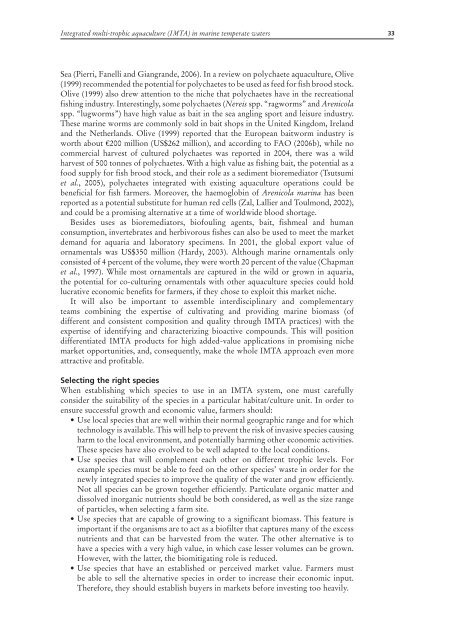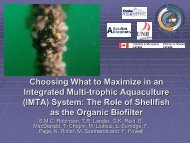Integrated multi-trophic aquaculture (IMTA) in marine temperate waters
Integrated multi-trophic aquaculture (IMTA) in marine temperate waters
Integrated multi-trophic aquaculture (IMTA) in marine temperate waters
You also want an ePaper? Increase the reach of your titles
YUMPU automatically turns print PDFs into web optimized ePapers that Google loves.
<strong>Integrated</strong> <strong>multi</strong>-<strong>trophic</strong> <strong>aquaculture</strong> (<strong>IMTA</strong>) <strong>in</strong> mar<strong>in</strong>e <strong>temperate</strong> <strong>waters</strong> 33<br />
Sea (Pierri, Fanelli and Giangrande, 2006). In a review on polychaete <strong>aquaculture</strong>, Olive<br />
(1999) recommended the potential for polychaetes to be used as feed for fish brood stock.<br />
Olive (1999) also drew attention to the niche that polychaetes have <strong>in</strong> the recreational<br />
fish<strong>in</strong>g <strong>in</strong>dustry. Interest<strong>in</strong>gly, some polychaetes (Nereis spp. “ragworms” and Arenicola<br />
spp. “lugworms”) have high value as bait <strong>in</strong> the sea angl<strong>in</strong>g sport and leisure <strong>in</strong>dustry.<br />
These mar<strong>in</strong>e worms are commonly sold <strong>in</strong> bait shops <strong>in</strong> the United K<strong>in</strong>gdom, Ireland<br />
and the Netherlands. Olive (1999) reported that the European baitworm <strong>in</strong>dustry is<br />
worth about €200 million (US$262 million), and accord<strong>in</strong>g to FAO (2006b), while no<br />
commercial harvest of cultured polychaetes was reported <strong>in</strong> 2004, there was a wild<br />
harvest of 500 tonnes of polychaetes. With a high value as fish<strong>in</strong>g bait, the potential as a<br />
food supply for fish brood stock, and their role as a sediment bioremediator (Tsutsumi<br />
et al., 2005), polychaetes <strong>in</strong>tegrated with exist<strong>in</strong>g <strong>aquaculture</strong> operations could be<br />
beneficial for fish farmers. Moreover, the haemoglob<strong>in</strong> of Arenicola mar<strong>in</strong>a has been<br />
reported as a potential substitute for human red cells (Zal, Lallier and Toulmond, 2002),<br />
and could be a promis<strong>in</strong>g alternative at a time of worldwide blood shortage.<br />
Besides uses as bioremediators, biofoul<strong>in</strong>g agents, bait, fishmeal and human<br />
consumption, <strong>in</strong>vertebrates and herbivorous fishes can also be used to meet the market<br />
demand for aquaria and laboratory specimens. In 2001, the global export value of<br />
ornamentals was US$350 million (Hardy, 2003). Although mar<strong>in</strong>e ornamentals only<br />
consisted of 4 percent of the volume, they were worth 20 percent of the value (Chapman<br />
et al., 1997). While most ornamentals are captured <strong>in</strong> the wild or grown <strong>in</strong> aquaria,<br />
the potential for co-cultur<strong>in</strong>g ornamentals with other <strong>aquaculture</strong> species could hold<br />
lucrative economic benefits for farmers, if they chose to exploit this market niche.<br />
It will also be important to assemble <strong>in</strong>terdiscipl<strong>in</strong>ary and complementary<br />
teams comb<strong>in</strong><strong>in</strong>g the expertise of cultivat<strong>in</strong>g and provid<strong>in</strong>g mar<strong>in</strong>e biomass (of<br />
different and consistent composition and quality through <strong>IMTA</strong> practices) with the<br />
expertise of identify<strong>in</strong>g and characteriz<strong>in</strong>g bioactive compounds. This will position<br />
differentiated <strong>IMTA</strong> products for high added-value applications <strong>in</strong> promis<strong>in</strong>g niche<br />
market opportunities, and, consequently, make the whole <strong>IMTA</strong> approach even more<br />
attractive and profitable.<br />
Select<strong>in</strong>g the right species<br />
When establish<strong>in</strong>g which species to use <strong>in</strong> an <strong>IMTA</strong> system, one must carefully<br />
consider the suitability of the species <strong>in</strong> a particular habitat/culture unit. In order to<br />
ensure successful growth and economic value, farmers should:<br />
• Use local species that are well with<strong>in</strong> their normal geographic range and for which<br />
technology is available. This will help to prevent the risk of <strong>in</strong>vasive species caus<strong>in</strong>g<br />
harm to the local environment, and potentially harm<strong>in</strong>g other economic activities.<br />
These species have also evolved to be well adapted to the local conditions.<br />
• Use species that will complement each other on different <strong>trophic</strong> levels. For<br />
example species must be able to feed on the other species’ waste <strong>in</strong> order for the<br />
newly <strong>in</strong>tegrated species to improve the quality of the water and grow efficiently.<br />
Not all species can be grown together efficiently. Particulate organic matter and<br />
dissolved <strong>in</strong>organic nutrients should be both considered, as well as the size range<br />
of particles, when select<strong>in</strong>g a farm site.<br />
• Use species that are capable of grow<strong>in</strong>g to a significant biomass. This feature is<br />
important if the organisms are to act as a biofilter that captures many of the excess<br />
nutrients and that can be harvested from the water. The other alternative is to<br />
have a species with a very high value, <strong>in</strong> which case lesser volumes can be grown.<br />
However, with the latter, the biomitigat<strong>in</strong>g role is reduced.<br />
• Use species that have an established or perceived market value. Farmers must<br />
be able to sell the alternative species <strong>in</strong> order to <strong>in</strong>crease their economic <strong>in</strong>put.<br />
Therefore, they should establish buyers <strong>in</strong> markets before <strong>in</strong>vest<strong>in</strong>g too heavily.



